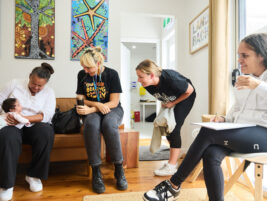The development of rigorous testing methods is critical for scientific inquiry. Our profession relies on the foundation of reliable and valid measurement of constructs to validate theories of human development and inform interventions to support optimal outcomes for children. As a result, gold standard tests become our primary trusted source of information. Yet, psychometrics is not without complexity and psychometric testing has a particularly troubling relationship with human diversity. Uninterrogated endorsed measures pose the risk of painting human diversity as deficient.
South Africa provides a stark example of how psychometric measures can be intentionally used to discriminate and even oppress. During Apartheid, culturally biased tests were used to deny educational and economic opportunities to Black South Africans, and ultimately to exploit Black labour and oppress people of colour (Laher & Cockcroft, 2013), the consequences of which still affect millions of Black South Africans 30 years after democracy and liberation.
The possibility of cultural bias in infant mental health construct measurement is critical to engage with, particularly given that parenting practices, contexts and socialization goals for infants are highly diverse globally (LeVine, 1974; Keller & Otto, 2009). Different contexts require different skills to navigate them successfully; and given global differences in cultural values and socialization goals, parenting must and should look different in different contexts.
Mary Ainsworth was mindful of this in some of the earliest measurement development in infant mental health. The Strange Situation Procedure, the gold standard for assessing attachment security in infancy, is an adaptation of procedures originally developed in Uganda (Ainsworth & Marvin, 1995; Otto, 2018). Ainsworth noted that procedural changes were required to evaluate attachment behaviours in the US, as compared to in Uganda, due to variations in infants’ typical experiences, which influence what is considered strange or stressful and the intensity of these stressors. During her interview with Robert Marvin in 1995, Ainsworth noted “I have been quite disappointed that so many attachment researchers have gone on to do research with the Strange Situation rather than looking at what happens in the home or in other natural settings – like I said before, it marks a turning away from “field- work,” and I don’t think it’s wise” (Ainsworth & Marvin, 1995, p12).
As infant mental health research and practice extends across the globe, it is imperative that we interrogate the suitability of measures for context. Many of the gold standard tools used in infant mental health research today were developed in parts of the world that represent less than 10% of the global population (Heinrich et al., 2010; Mesman & Emmen, 2016).
Measures of sensitive responsiveness provides a pertinent example. Meta-reviews have shown that current measures of sensitive responsiveness are not strong predictors of attachment security among families from low socio-economic backgrounds (Woodhouse et al., 2020), and studies have sought to understand this. One study in South Africa compared the sensitive responsiveness scores of Black African mothers using two different measures, showing lower mean scores when tests specified behaviours as sensitive or insensitive; and finding that a measure developed in North America correlated with education, while a measure developed in Africa did not (Dawson et al., 2021). This study also found that certain behaviours were relatively absent in the sample, aligning with anthropological studies on cultural variations (Dawson, 2018). Similar findings have been noted in Pakistan, where differences in parental behavioural profiles highlighted potential biases in responsivity testing (Hentschel et al., 2024). In addition, in North America, a study found that an adapted construct, secure base provision, was a better predictor of attachment security in Black and Hispanic families than sensitive responsiveness (Woodhouse et al., 2020).
Theoretical arguments have also been made regarding the contextual and cultural appropriateness of parental mentalizing measures, which analyse interview answers for the presence of mental state language. While little research exists into the measures cross-cultural validity, cultural differences have also been found to exist with regards to the value placed on reflecting on mental states (Aival-Naveh et al., 2022), and mentalizing theory has been critiqued for its Cartesian underpinnings, the philosophical idea of a mind separate from the body (Køster, 2017). African Zulu speakers, for example, may be disadvantaged by such a measure, as their epistemological framework does not conceptualize a mind separate from the body, and their language contains limited mental state language as a result (Mbaegbu, 2016).
Broader issues of measurement of infant mental health constructs in diverse settings have also been noted. For example, measures are frequently designed to consider dyads (infant and primary caregiver), or triads, centring a parental couple as caregivers (Mesman & Emmen, 2016). Such measures are not easily applied in contexts where alloparenting is common, and caregiving constellations are made of more nuanced family networks. While there have been proposed ways to adapt sensitivity measures for alloparenting contexts (Mesman et al., 2018), such ways of working remain uncommon.
Much is at stake. In a global world where international research increasingly drives the development of interventions for low and middle-income countries, it is ethically imperative to ensure that our measures are culturally and contextually valid. Without this consideration, we risk perpetuating a view of difference as deficient (Scheidecker et al., 2022). By critically examining and adapting our tools, and requiring contextual responsiveness, rather than framing it as a deviation from the gold standard, we can foster a more inclusive and accurate understanding of infant mental health and parenting for optimal child development across diverse contexts. Doing so is a critical step towards promoting equity and justice in the field of infant mental health, ensuring that all children, regardless of their culture and context, are appropriately supported to thrive.
References
Ainsworth, M. D., & Marvin, R. S. (1995). On the shaping of attachment theory and research: An interview with Mary DS Ainsworth (Fall 1994). Monographs of the society for research in child development, 3-21.
Aival-Naveh, E., Rothschild-Yakar, L., Park, J., & Kurman, J. (2022). The value of thinking about feelings across cultures: a preliminary investigation of the mentalizing values scale. Journal of Cross-Cultural Psychology, 53(3-4), 362-379.
Dawson, N. K. (2018). From Uganda to Baltimore to Alexandra Township: How far can Ainsworth’s theory stretch?. South African Journal of Psychiatry, 24.
Dawson, N., Bain, K., & Mesman, J. (2021). Observing maternal sensitivity in a South African township: An exploratory study into behavioral features using different measures. Attachment & Human Development, 23(2), 150-163.
Heinrich, J., Heine, S. J., & Norenzayan, A. (2010). The wierdest people in the world? Behavioral and Brain Science, 33(2-3), 61-135. https://doi.org/10.1017/S0140525X0999152X
Hentschel, E., Siyal, S., Warren, W., Lanjar, S., McCoy, D. C., Tiemeier, H., & Yousafzai, A. K. (2024). “When I hold my daughter, she quiets, no need [for] any verbal conversation”: A qualitative understanding of responsive caregiving in rural, Sindh Pakistan. Infant Mental Health Journal.
Keller, H., & Otto, H. (2009). The cultural socialization of emotion regulation during infancy. Journal of cross-cultural psychology, 40(6), 996-1011.
Køster, A. (2017). Mentalization, embodiment, and narrative: Critical comments on the social ontology of mentalization theory. Theory & Psychology, 27(4), 458-476.
Laher, S., & Cockcroft, K. (2013). Contextualising psychological assessment in South Africa. Psychological assessment in South Africa: Research and applications, 1-16.
LeVine, R. A. (1974). Parental goals: A cross-cultural view. Teachers College Record, 76(2), 1-10.
Mbaegbu, C. C. (2016). The mind body problem: The hermeneutics of African philosophy. UNIZIK Journal of Religion and Human Relations, 8(2), 2-18.
Mesman, J., & Emmen, R. A. (2016). Mary Ainsworth’s legacy: A systematic review of observational instruments measuring parental sensitivity. Maternal Sensitivity, 43-64.
Mesman, J., Minter, T., Angnged, A., Cissé, I. A., Salali, G. D., & Migliano, A. B. (2018). Universality without uniformity: A culturally inclusive approach to sensitive responsiveness in infant caregiving. Child Development, 89(3), 837-850.
Otto, H. (2018). Culture and attachment in Africa. Child and adolescent development: An expanded focus on public health in Africa, 141-158.
Scheidecker, G., Chaudhary, N., Oppong, S., Röttger-Rössler, B., & Keller, H. (2022). Different is not deficient: Respecting diversity in early childhood development. The Lancet Child & Adolescent Health, 6(12), e24-e25.
Woodhouse, S. S., Scott, J. R., Hepworth, A. D., & Cassidy, J. (2020). Secure base provision: A new approach to examining links between maternal caregiving and infant attachment. Child Development, 91(1), e249-e265.
Authors
Nicki Dawson,
South Africa








